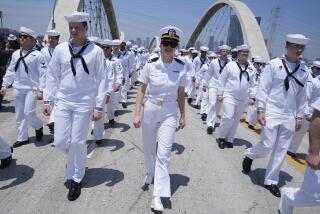Launch of Slave Ship’s Replica Draws Thousands
- Share via
MYSTIC, Conn. — More than a century ago, Sengbe Pieh led slaves aboard the Amistad in a revolt in which they overthrew their captors in an effort to return to their homeland.
On Saturday, the launching of a replica of the schooner gave Pieh’s great-grandson hope for the future and optimism that his ancestor’s fight for freedom would soon be heard around the world.
“It’s unbelievable that an icon of slavery is being transformed in this millennium into an icon of partnership, faith in each other and of human rights for all of us,” said Samuel Pieh, who runs an organization that works to improve relations between Africa and the United States.
Thousands, including American and Sierra Leone dignitaries and descendants of the Amistad captives, watched and cheered as the 138-ton vessel was lowered into the Mystic River.
The ship was christened with water from Cuba, Long Island and Sierra Leone--where the slaves were sold, captured by American authorities and finally returned home.
Shirley Yema Gbujama, the minister of social welfare, gender and children’s affairs in Sierra Leone, and African American actress Ruby Dee broke the bottle of water over the ship’s bow.
A brass bell tolled for each of the ship’s 53 captives.
The six-year, $3.1-million project marked the beginning of the unending task of teaching histories, forgotten stories and improving race relations, organizers said.
“She represents friendship, which is the translation of the name Amistad, cooperation . . . all of the good stuff,” said Warren Marr II, who began in 1976 to push for the project.
The slaves took control of the original Amistad near Cuba in 1839. Their story was depicted in a 1997 movie by Steven Spielberg.
Led by Sengbe Pieh, the slaves killed the captain of the Spanish ship and tried to force its crew to sail them back to Africa. The ship wandered up the East Coast before landing on Long Island. They were captured there, brought to New London and then jailed in New Haven. Several trials followed.
An 1841 U.S. Supreme Court ruling freed the slaves, whose cause had been taken up by white abolitionists and former President John Quincy Adams. The 35 Africans who survived returned to their homeland in 1842 and established churches and schools for others.
“Our mission is to tell the story of the Amistad as well as the story of the human rights struggle that exists today,” said William Pinkney, the ship’s captain. “We want to show young people what can happen with cooperation.”
The ship will dock around the world, including Cuba and Sierra Leone.
More to Read
Sign up for Essential California
The most important California stories and recommendations in your inbox every morning.
You may occasionally receive promotional content from the Los Angeles Times.













